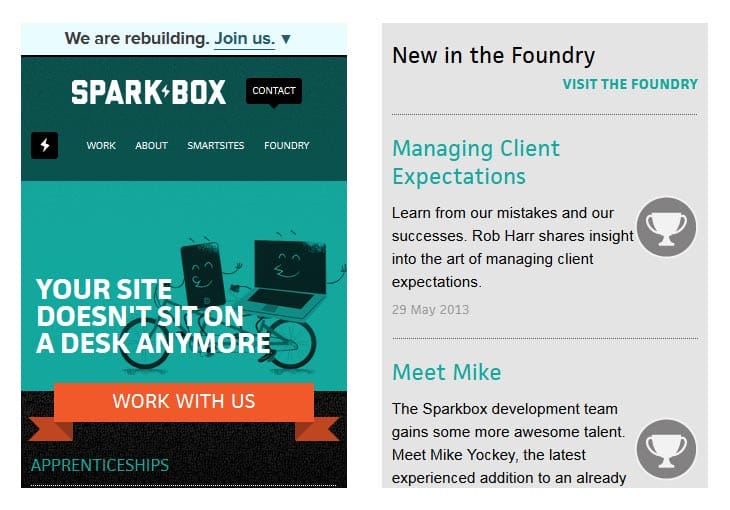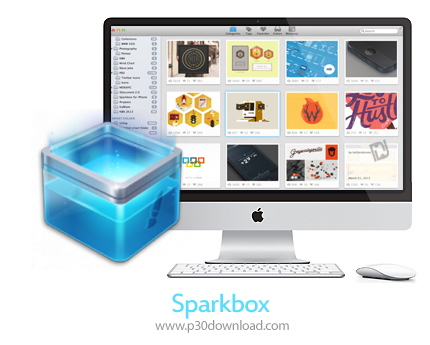
In the first months of your apprenticeship, you'll be exposed to the core technologies of our work and work flow.


#SPARKBOX DATACENTER CODE#
We're looking for folks interested in web development - frontend, backend, or anything code related. This curriculum is for the kind of people who are ready to pour themselves into it - eager to pick up everything they can. Learning technical skillsets isn't easy work, and the curve can be steep. A long resumé is not - as long as you care about the right things, we can help build your skillset. Passion, character, and initiative are a requirement. We build responsive, standards-compliant, content-focused, well-crafted, accessible, beautiful web sites and apps, and we're looking for other web geeks who want to do the same.

If you're crazy about the idea of becoming a well-rounded web developer, yet aren't quite sure where to start, we think you've found just the right place to begin. If you're not in our area, no problem! We're outlining our entire program here for you to do on your own - or to introduce to your team. We hate the idea of keeping our apprenticeship program to ourselves, though. We offer paid apprenticeships at our Dayton office because we love what we do, we want to help create new talent, and we genuinely care about the future of the web. Sparkbox is a team that values education. We are slowly translating our Sparkbox apprenticeship content into a useful format here on GitHub. I don’t foresee needing to do this often, but it’s nice to know that all the tools are in place to make replacing pieces of our infrastructure quick and easy.Disclaimer: This guide is under construction. Rather than buying and shipping an expensive server to a datacenter, we clicked our way through a web app and had a new instance available to us right away. The unsung hero here are the hosting options available to us today.
#SPARKBOX DATACENTER UPGRADE#
We were not confident that we’d be able to upgrade this server without extraordinary effort and significant downtime. Now that old server can be safely retired and removed from your deployment automation.ĭevelopment of this procedure was borne out of necessity for us. We will indeed clear all tasks managed by Whenever on both servers, but the tasks only get added back to the new server because of our clever configuration from before. Remember that our tasks are limited by the server’s role. The second is to actually write the crontab to both servers based on Whenever’s configuration.Ĭutover_tasks.sh: $ cap production whenever:clear_crontab The first step is to clear all cronjobs from both servers (the new server’s crontab is empty, and that’s okay). By configuring our new and old servers to exist in their own Capistrano roles in the deploy configuration we primed Whenever to perform the seamless cutover we required. With that option set, Whenever limits the servers on which it will define those tasks. This turned out to be a great thing because that meant we could expand Whenever’s set of roles without having those tasks defined on more servers. Our Whenever schedule has many more tasks than this, but they all define the roles option. This is what it looks like:ĭeploy.rb: server '0.0.0.0', roles: %w # New app server gets the existing roles After looking closely at this aspect of our configuration we realized that we could use Capistrano’s concept of servers fulfilling roles in an application to perform our cutover. We were also using its integration with our deployment automation tool Capistrano to limit background jobs to running only on our task server and not the web servers. Whenever provides a Ruby API to describe cron jobs, then converts them to cron syntax and inserts the rules into the server’s crontab. We use the Whenever Ruby gem to manage scheduling of background tasks. What we found was that our existing task scheduling and deployment automation were flexible enough to fulfill these requirements. Only then could we delete the old instance. Instead, we needed to simultaneously start running tasks on a new server while stopping them on the existing one. However, a dedicated task server on the project couldn’t simply be taken offline, nor could we risk running two of them with different Ruby versions.

Servers meant to service web requests were easy remove them from the load balancer and shut them down. A recent upgrade to Ruby 2 left us with some servers to retire.


 0 kommentar(er)
0 kommentar(er)
